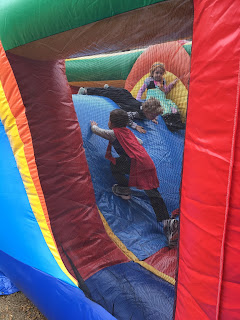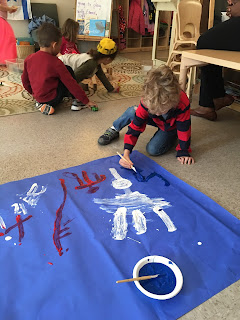We've had such a fun week in the Tzemach class! As you remember from my last post, we are marine biologist! As scientists, we've been spending a lot of time in research. Last week we introduced the kids to a large number of sea creatures. We vaguely explored each creature together as a whole class. This week we wanted to make it more individualized. We wanted the kids to feel that they were real experts. We wanted them to go to their friends with questions about a sea creature and be able to get answers. We started by asking them which creature was their favorite. Which one did they want to research? Which one were they most curious about? Which one did they want to become an expert in? After selecting their creature of choice, we dove into our research.
To start our research we spent a lot of time in books. We had the books spread out and encouraged the kids to look through them and find pictures of their creature. Once they found a book that held information, we sat down one on one and read through the books. We asked questions and tried to find answers. If we couldn't find answers in our books, we turned to the internet. We sat down with the kids and put our questions into Google. We pulled up articles to read and explored pictures. We also wanted the kids to look at a short video of their creature to see it in action. After learning their picks, we found short 2-3 minute videos that gave a general explanation of the creature. Most of our research included: their living environment, what they ate, their behaviors, what parts of the world they lived in, and any other questions that the kids could think of. Between the books, articles, and videos, we discovered that we had learned a lot about our creatures! We were able to tell friends facts about our sea creatures! We were becoming experts!
As experts, we decided that we should share that information with others. We talked about the fact that marine biologist do research and when they make discoveries they share that knowledge with others. That's why we know so much about the world...someone discovered it and they shared it with us! To share our facts we thought it'd be best to write a book about our sea creature. We've written some fiction books throughout the year but never a non fiction. We started by talking through non fiction books with each child. We discussed the different parts of a book and their function. We discussed the difference between fiction and non fiction and why each was important. We gave the kids complete liberty of what facts they chose and how long they wanted their book to be. We became the author and illustrator for each page. We were careful to fill the pages with correct information. If we couldn't remember something we learned, we dove back into our books and searched for answers. Our pages consisted of things such as: the name of our creature, where they live, what they eat, interesting facts we discovered, and some of our favorite characteristic about our creature. I am in.love.with.these.books. Seriously. They really got excited about being experts and they took it seriously. They carefully drew their pictures to match their facts. They spent a lot of time working on their books. We didn't expect them to take up the majority of the week but they did. And that's ok! We were glad they got so involved. These are hanging up in the hallway so make sure you check them out.
After the fun mural we made last week, some of the kids wanted to do some more painting. This time they worked on individual artwork and painted creatures of their choosing. You can find these in the hallway along with their statements about their piece. Next week we will be jumping head first into our 3D creatures. If you have any recycled items at home, please bring them in. We want to give the kids tons of materials so they can get creative. Right now, the kids are saying they'd like to hang their 3D artwork from the ceiling to make the room look like the ocean. I think it's a great idea! I'm sure it will take us most of next week, but soon our classroom with come to life with sea creatures! We are also working to get a guest speaker next week. We're hoping he can come by and teach us all about the ocean and answer some more of our questions.
We're looking forward to another great week!
Love,
Rachael
Approaches to Learning:
- Demonstrate growing ability to predict possible outcomes based on prior experiences and knowledge.
- Demonstrate increasing ability to use prior knowledge to understand new experiences.
- Represent prior events and personal experiences in one or more ways.
- Try to solve problems encountered in play.
- Demonstrate an increasing ability to follow through with tasks and activities.
- Interact easily with familiar adults by engaging in conversations, responding to questions and following direction.
- Participate in group life of class.
- Demonstrate strategies to join play group with adult support.
- Recognize effect on others of own behavior most of the time.
- Manage transitions positively when told what to expect.
- Show interest in informational texts about familiar objects.
- Retell one or town events from a story read aloud.
- Begin to identify significant words from text read aloud.
- Explore books independently.
- Incorporate information from informational texts into play activities.
- Begin to understand the relationship between oral language and written language.
- use drawings, letters, or words to create narratives about people and things in their environment.
- Investigate solutions to simple problems.
- Classify objects in their environment by color, shape, size, or function.
- Begin to show an awareness of numbers in the environment.
- Sort and classify objects by one attribute.
- Represent simple two-dimensional geometric shapes.
Exploring oceans through play during center time...
We are researchers! Learning all about our favorite sea creatures...
We are writers! Check out our non fiction books in the hallway...
































































